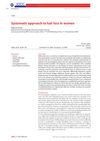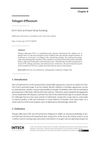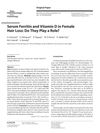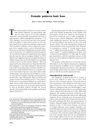Co-Morbidities Associated With Diffuse Hair Loss in Women
January 2019
in “
Zenodo (CERN European Organization for Nuclear Research)
”
TLDR Diffuse hair loss in women is often linked to anemia, thyroid issues, and conditions like polycystic ovarian disease.
This observational study conducted on 200 women aged 15-45 years at a tertiary urban hospital in India aimed to identify the prevalence of conditions associated with non-scarring diffuse hair loss. The most common types of hair loss identified were chronic telogen effluvium (35.5%), female pattern hair loss (35%), and telogen effluvium (23%). Anemia was prevalent in 35.5% of cases, making it the most common co-morbidity across all types of diffuse hair loss. Other significant triggers and associated conditions included fever, postpartum hemorrhage, emotional stress for telogen effluvium; hirsutism, obesity, polycystic ovarian disease, hypothyroidism, and diabetes for female pattern hair loss; and hypothyroidism and polycystic ovarian disease for chronic telogen effluvium. The study highlighted the importance of thorough examination and relevant investigations to detect and treat associated conditions in women with diffuse hair loss.





